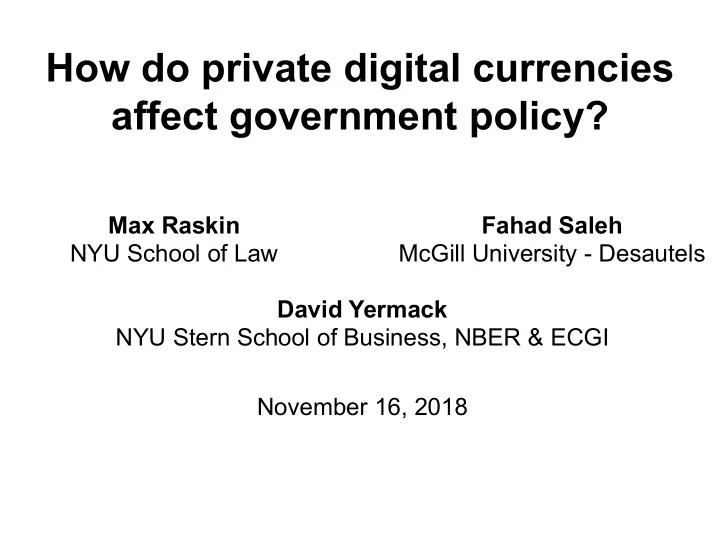

How do private digital currencies affect government policy? Max Raskin Fahad Saleh NYU School of Law McGill University - Desautels David Yermack NYU Stern School of Business, NBER & ECGI November 16, 2018
We have the first global currency crises since the invention of private digital currency
Digital currencies, most prominently Bitcoin, circulate alongside unstable fiat currencies
Main Finding 1: Digital currencies enhance citizen welfare • Risk Reduction Non-positive correlation with local economic risks provides investors with a diversification opportunity • Restrained Monetary Policy The difficulty of excluding digital currencies from the market reduces gains from seigniorage, thereby inducing lower inflation
Main Finding 2: Digital currencies encourage local investment • Diversification Digital currencies serve as a hedge asset, thereby facilitating investment in high-risk economies • Credible Commitment Digital currenciess facilitate a credible commitment to disciplined monetary policy, thereby enhancing expected returns from local investment
Main Finding 3: Digital currencies may be desirable for corrupt sovereigns • Local Investment Increased local investment yields higher tax revenue (holding tax rates constant) • Welfare Gains Governments may extract some of the welfare gains via increased tax rates
Typology Private Decentralized Private Centralized Digital Currency Digital Currency Public Decentralized Public Centralized Digital Currency Digital Currency
Centralized digital currencies ● Public ● Many investigating, few implementing - E.g. Sweden, Ecuador, Venezuela ● Narrowing of banking system, - Similar to Chicago Plan of 1933 ● Central bank retains monopoly power ● Can alter ledger or rules to defeat private choice ● Private ● Easier to regulate companies than individuals ● History of numerous shutdowns - E.g., Liberty Reserve ● Stablecoins, such as Tether, interact with traditional banking system
Decentralized digital currencies ● Often politically motivated ● E.g., Nakamoto and Bitcoin ● Rules-based monetary policy, implemented by decentralized consensus ● Can only be suppressed by closing extraterritorial nodes ● Compare Bit Torrent ● Capital control resistant ● Bearer instruments, with no recognition needed from legal system ● Similar to gold, cigarettes, shells, etc. ● Requires user to control private key
Related literature • Central banks and digital currency Raskin and Yermack (2016), Bordo and Levin (2017), Fung and Halaburda (2017) • Digital currency return properties Yermack (2015), Dyhrberg (2016a, 2016b), Liu and Tsyvinski (2018), Hinzen (2018) • Digital currency economic design Routledge and Zetlin-Jones (2018), Saleh (2018)
Model • Two agents - Government - Citizen • Three assets - Local productive capital - Unproductive capital - Private digital currency (if permitted) • Two dates (i.e., agents are short-lived)
Model: Assets • Local productive capital - Taxable - Proxy for local investment • Private digital currency - Untaxable (reflects enforcement difficulty) - Non-positively correlated with local economy • Unproductive capital - Zero real return
Model: Government max (E[Tax revenue] + E[Seigniorage]) • t = 0 - Government decides whether to permit private digital currency - Government sets tax rate for local investment • t = 1 - Government sets inflation rate - Government consumes
Model: Citizen max (E[R p ] - .5 Var[R p ]) • t = 0 - Citizen invests among available assets • Local productive capital • Unproductive capital • Private digital currency (if permitted) • t = 1 - Payoffs realized - Citizen pays taxes; faces inflation - Citizen consumes
Model: Monetary policy ( t = 1) Seigniorage = Money Growth x Real Money Demand • Higher inflation directly increases seigniorage • Higher inflation indirectly lowers seigniorage revenue by lowering real money demand • Interior optimal inflation rate (Cagan, 1956)
Model: Monetary policy ( t = 1) • Private digital currency strengthens the negative effect of inflation on local fiat money demand by creating an outside option • Outside fiat cannot fill identical role, because traditional fiats are easier for governments to restrict • Private digital currency enables credible commitment by the sovereign to (more) restrained monetary policy
Model: Fiscal policy ( t = 0) Tax Revenue = Tax Rate x Local Investment Return • Higher tax rate directly increases tax revenue • Higher tax rate indirectly lowers tax revenue by discouraging local investment • Private digital currency serves as alternative asset and therefore restrains fiscal policy
Model: Regulatory policy ( t = 0) • Digital currency as a complement to local investment – Permitting digital currency facilitates diversification which encourages local investment • Digital currency as a substitute for local investment – Permitting digital currency enables citizens to substitute away from local investment • Digital currency is not taxable, so government optimizes based on revenue extracted from local investment
Results: Citizen welfare
Results: Local investment
Results: Government welfare
What if private digital currencies were better designed? • Higher productivity (Cong, Li and Wang 2018) • Lower volatility (Saleh 2018)
Results: Government welfare
Results: Citizen welfare
Conclusions • Private digital currencies may improve welfare in some emerging market economies • Selfish governments may wish to permit trading of private digital currencies • Our results highlight the need for work on the economic design of private digital currencies
Recommend
More recommend